When you think about it, a survey is a pretty remarkable tool.
A list of question and answers transform into opinions, charts, and graphs—which turn into insights that can move your business forward.
The trouble is, it can be difficult to imagine the end result when you’re deep in the weeds of actually writing a survey. Should you include that last question? How will the answers actually help your business?
Without experience—or examples—it can be tough to connect how asking a question can lead to an insight that can truly change how you do business.
To help you imagine what business-changing survey results can look like, let’s walk through three examples of imaginary companies with realistic challenges. While each company uses surveys in different ways, they all deliver crucial insights for each use case.
Your customers’ opinions can make or break your business
CarpoolLane is a fast-growing ride-sharing startup with a lot of ground to cover. Nobody wants to be caught in the shade of giants like Uber and Lyft, so CarpoolLane differentiates themselves by offering a premium customer experience. How’s that strategy paying off? Pretty well, judging by the Net Promoter Score® (NPS) question responses on their quarterly survey.
These are customer satisfaction rates many companies would be envious of. They’re the perfect metrics to show to higher-ups—or investors—that there’s demand, or at least appreciation for the type of service they’re offering.
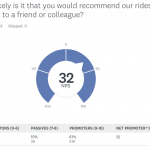
NPS, Net Promoter & Net Promoter Score are registered trademarks of Satmetrix Systems, Inc., Bain & Company and Fred Reichheld.
While the overall rider experience is running smoothly, one or two areas may need to get into gear. There’s some real room for improvement in the customer support organization—particularly for a brand built on a customer-first mentality. This is an area that needs to be addressed quickly before CarpoolLane's brand is damaged. Nice catch!
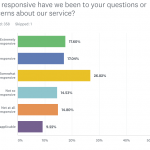
Multiple choice questions are perfect for gathering data about topics you’re already aware of—rider satisfaction, customer interactions, etc. But open-ended questions and comment boxes let your customers tell you about issues you might not have known they had.
Take the responses to CarpoolLanes’s open-ended question, for example. An overwhelming number of respondents said they needed a way to separate business trips from personal trips. That’s an easy fix that’s sure to further boost CarpoolLanes’s already stellar overall satisfaction scores.
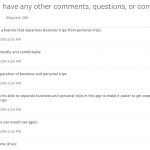
Want to see the rest of the ridesharing startup’s survey results? Check them out and see how else they improved their business with insights from their survey! See survey results →
Your employees have the answer to building a better workplace
Your customers aren’t the only people who can guide how you run your business. It’s important to give your employees a say, too.
For example, let’s look at
DeliverShip, a mid-sized delivery company that takes pride in how they
treat their employees. Their HR department does a great job of fitting employees to the exact jobs that they’re cut out for, and they make sure to offer competitive benefits and salaries.
How does a strong HR department affect overall employee engagement at their company? One strong indicator of engagement is whether employees feel they’re using their best skills in their job every day. At DeliverShip, it seems like a lot of employees are on board with this, a good sign that the company’s HR and management practices have been successful.

It’s not all smooth sailing, though. While the
DeliverShip’s diligent HR department makes sure that all
their employees are paid fairly in relation to the market, their workforce doesn’t necessarily see it that way. This is easy enough to address: If the HR department opens up about their methods for evaluating salaries, they’re sure to see these numbers rise—and along with it, overall employee engagement.
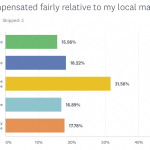
Want to see more ways DeliverShip can improve the employee experience? Check out the rest of their survey results! See survey results →
Your consumers can help you find the best way to go to market
Everyone wants to get to know their customers better, preferably before they even start selling to them. That’s why companies like all-natural pet food maker PuppyLove, test product concepts, logos, and advertisements with consumers in new markets long before they ever hit the shelves.
Ad A
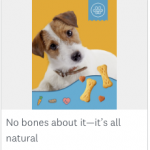
Ad B

Out of the two ad taglines above, which will motivate PuppyLove’s consumers to buy? Which appeals to consumers the most? Which seems most unique? The best way for PuppyLove to sniff out the truth is to ask potential consumers directly. The results are pretty convincing. Ad A (“No bones about it—it’s all natural”) significantly outperforms Ad B (“Only the best for your best friend”) in the most important category: purchase intent.
Ad A
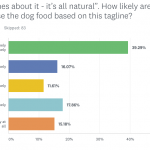
Ad B
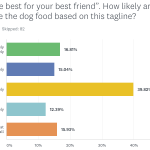
That doesn’t mean PuppyLove should just throw out ad concept B, though. Let’s take a look at where it performed well for more context about the winning ad. Nearly two out of every five consumers (39%) thought the losing ad’s tagline was "Extremely unique,” while the winning ad scored much lower—even though they said they were likely to buy it. This might suggest that the “all natural” claim is what’s most important here. Based on these insights, PuppyLove is going to send another survey soon to test ad concepts that showcase their natural ingredients.
Related: Learn everything you need to know to run your own concept test from start to finish in our comprehensive guide.
PuppyLove may have just uncovered a breakthrough for future ads: This test could indicate that whether an ad is unique doesn’t have much bearing on purchase intent. That’s valuable to know for the future!
Ad A
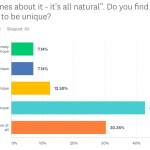
Ad B
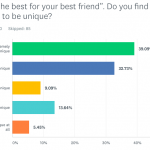
Check out the rest of the survey results to see what else PuppyLove uncovered about their consumers’ thoughts and preferences. See survey results →
It can be easy to forget how powerful the information you get from surveys can be until you see the end result.
Survey data helped CarpoolLane steer clear of potential customer service problems. DeliverShip’s loyal employees might have become frustrated with salaries that were well within the market rate. PuppyLove could have made ad choices that may not have gotten much love from their consumers.
Coming up with the perfect questions to get at the root of your organization’s most important issues can be tough, but it pays off in the end.
See all three examples in action in your SurveyMonkey account so you can get inspiration for your next survey! See examples →



